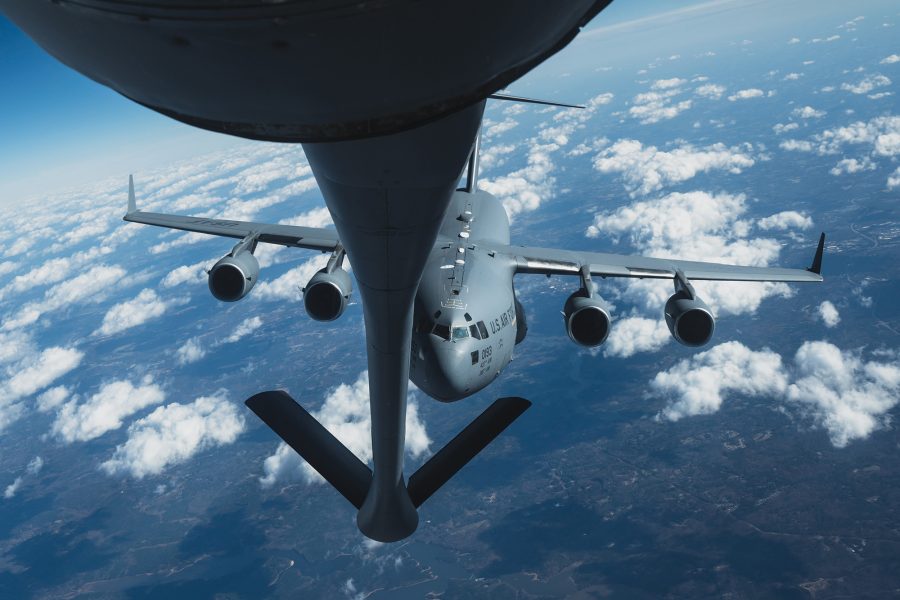Editor’s Note: This story was updated July 24 to properly identify the source of several quotes; to correct the level of funding needed to reach AMC’s connectivity goal; and to clarify that Gen. Minihan did not say to what level the AMC fleet will have connectivity by 2025. Air & Space Forces Magazine regrets these errors.
Air Mobility Command will not meet Gen. Mike Minihan’s goal of equipping a quarter of its fleet with modern connectivity and situational awareness gear by fiscal 2025, but it remains an urgent need, he told lawmakers July 23.
Minihan, making his last appearance before the House Armed Services Committee as AMC commander, said achieving the “25 by ’25” goal by the end of his tenure in the next few months “regrettably, is not possible.”
Rep. Joe Courtney, citing staff members, said it would take $500 million to reach the 25 by ’25 goal, which would provide crews with urgently needed situational awareness. The upgrades were not included on the Air Force’s unfunded priorities list because the service is trying to do away with such off-budget requests, and Chief of Staff Gen. David W. Allvin felt that spare parts were a higher priority, Lt. Gen. David H. Tabor, director of programs, said.
The level actually achieved before his his self-imposed deadline is unclear, but when pressed by Rep. Mike Waltz on the state of upgrades, Minihan did say they would be spread evenly across the fleet to different kinds of aircraft. But as long as the fleet is short of full connectivity, it’s “vulnerable,” he said.
“We are behind” Minihan said, pledging that AMC is doing everything it can “to catch up.”
The connectivity package is different for almost every type in the inventory, he said, meaning there’s no one-size-fits-all unit, but most are a “roll-on” set of pallets.
The failure to have already achieved this urgent capability is due to “decades of under-investment in mobility,” Minihan said, which was thought acceptable as long as the U.S. operated in a permissive environment.
The upgrades will allow aircraft “to tie into the tactical data links that the joint force uses, and we will be able to tie back to all the command-and-control echelons that the joint force, the combatant commands, [and] certainly my team that runs an Air Operations Center that’s globally engaged every day back at Scott Air Force base, would be able to tie through to all of that,” he said.
The “precious first moments of conflict are sure to be dynamic, and it is critical that our most relied-upon assets have the connectivity, and therefore the awareness, to put our joint force in a position of advantage,” Minihan said.
The connectivity he’s seeking would include fast download speeds and detailed data such as the security situation at the destination, potential air-to-air and surface-to-air threats, availability of fuel at the destination, the ability to rapidly divert, and the ability to see where safer landing places, with necessary support, are available, under combat conditions, he said.
Recent noncombatant evacuation operations in Afghanistan and Niger have proved the utility of the upgrades on equipped aircraft.
“What we’re finding out now is, when an airplane takes off from Europe to go do a mission down to Niger, is we’ve got instant connectivity. We know the current status of the airfield. We know the current status of the of the joint force,” he said. “we know the security measures. We know the fuel state. We know the cargo state, and that ability is an absolute game-changer. It both helps with effective, effectiveness and efficiency, but most importantly, it helps with the security of Americans, you know, both the air crew and those on the ground.
Such connectivity “would have been wonderful to have during the Kabul evacuation. We didn’t. So what we’ve demonstrated is we’re taking those lessons learned, we’re backing it up with data, and then we’re moving forward with affordable capabilities that exist now that don’t require massive modifications to the airplanes, and we’re having wonderful effects in the airspace and on the battlefield,” he added.
The NEO in Niger will provide “another set of data points when it comes to that roll-on kit, and we’re incorporating all those lessons learned into everything we’re planning for the fall. There’s some big exercises going on this fall, and then, most importantly, into the summer exercise series in the Pacific that’s going to happen in 2025.”
He added that the Air Force is running out of time to do the upgrades. “Simply put, the longer we wait, the more risk the nation incurs, and the more expensive it is to solve it,” he said.
AMC is coordinating with the Air Force’s command, control, communications, and battle management efforts to integrate airlift with the Joint All-Domain Command and Control push, Minihan added.
The upgrades are a prerequisite for success in a Pacific conflict, he said.
“What we can’t do is ever put those teams in a position where they’re relying on nine-hour old intel to make the decisions,” he asserted.
Without the connectivity upgrades, mobility forces will be blind to troop movements and lack battlespace awareness, he warned.
